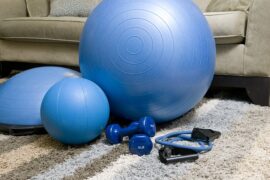As an older adult, you know that staying active is vital to any smart health and wellness plan. Regular exercise can help ward off cardiovascular disease, which is the leading cause of death for those age 65 and up, according to the Centers for Disease Control and Prevention (CDC). Indeed, physical activity is vital to helping prevent heart attack, stroke, and death, but there’s more to it than that. Getting active can also help senior citizens enjoy higher energy levels, a boost in mood, and stronger mental health.
In this guide, you’ll discover the basics to staying active if you’re a senior citizen (age 65 and up), with information on frequency and the best types of exercises to prevent injury.
How Much Exercise Do You Need?
So, we know that working out is essential, but how much is enough? According to the CDC, older adults should strive for at least 150 minutes of moderate-intensity aerobic activity (anything that gets your heart beating faster) or 75 minutes of vigorous-intensity aerobic activity (such as jogging or running) each week. On top of that, seniors should build in two muscle-strengthening sessions each week. How you spend those 150 minutes and two strengthening sessions is totally up to you, but some examples are:
- A half hour of brisk walking five days a week and two half-hour sessions of full-body muscle strengthening using machines at the gym.
- 15 minutes of running on the treadmill or cycling five days a week and two half-hour sessions of full-body muscle strengthening using machines at the gym.
If you have any heart conditions, suffer from serious bone or joint diseases, or have been diagnosed with any other serious illness, be sure to ask your doctor before taking up a new exercise regimen.

What Kinds Of Exercises Are Best?
There are three important kinds of exercise for senior citizens: cardiovascular activity (aerobic), strength-building activity, and range-of-motion activities. All of these kinds are important, both independently and for one another. When you’re building muscles, you’re improving balance and mobility, making cardio safer and more enjoyable. In truth, you can’t have one without the other two.
- Cardio – When it comes to older adults and cardio, it’s important to be gentle on the joints. High-impact activities can worsen joint pain and lead to serious injury, making it hard to work out at all. Stick to low-intensity activities, such as swimming, walking, or using an elliptical machine, to protect the bones. Be sure you have high-quality, supportive shoes to protect your feet, legs, and back.
- Strength – Building and maintaining strong muscles is key at any age, but as you get older it’s especially important because it helps bolster bones and joints, providing extra stability and protection. The main thing to know when deciding what strengthening activities to do is that it’s generally best for seniors to use guided weight machines at the gym rather than free weights. These machines provide guidance and whole-body support to prevent injury.
- Range-of-Motion – These kinds of exercises can help relieve stiffness and improve mobility, so they’re important to work into your routine a couple of times per week. They can also help increase flexibility and joint function. Some good movements to improve your range-of-motion include arm circles, elbow bends, and head tilts.

Tips For Staying Active
It’s clear that all people need to work out to stay happy and healthy throughout life, but for many people it’s easier said than done. You need to find exercise programs and support aids (such as pain relief options) that get you excited and make you want to continue your regimen. Here are some great tips to help.
- Manage joint pain with non-pharmaceutical pain therapies, such as massage, hydrotherapy, or low-level laser therapy. Using a laser light therapy belt can temporarily relieve some of that stubborn low back pain so you can get your exercises in each day. This kind of therapy is also designed to help relax the muscles, which can help you get a good night’s rest.
- Try an exercise class specifically for seniors, such as a water aerobics class, gentle yoga, or spinning. The beauty of signing up for a class such as this is that it encourages camaraderie, socialization, and accountability, which means you’ll be more likely to show up even if you lose interest.
- Get a personal trainer. Personal trainers aren’t just for athletes or weight lifters. On the contrary! They’re actually great for older adults and anyone who has mobility limitations, arthritis, and previous injuries. Your trainer will guide you through safe, gentle workouts that are tailored specifically to you.
- Use a fitness wearable. Who says fitness trackers and the apps that accompany them are just for young people? Wearable fitness devices, such as smartwatches and Fitbits, are actually especially useful to older adults because they can track vitals, such as heart rate, sleep, weight, and more. They also track your movement and exercise each day so you can get a good idea of how much work you’re doing.
![]()
Focus On Safe, Healthy Movement
As an older adult, you need exercise as much, if not more, than you did when you were young, but the many physical changes and health challenges you face can make working out riskier than it was for you 10 or 20 years ago. As a result, you need to take extra precaution to ensure that you burn calories and condition the heart in a way that doesn’t put you at risk of injury. Follow these great tips to keep staying active and remain in great shape the safe way!
*collaborative post


































